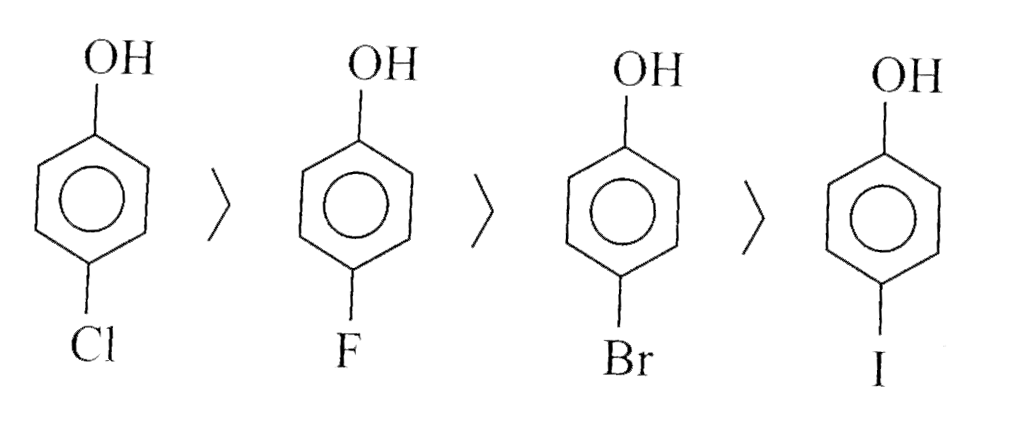Expalin the following:
a. Reactivity of halogens in the presence of halogen carrier (FeX3) with benzene is F2>Cl2>Br2>I2.
b. The reactivity of halogen-subsituted benzene towards SE reaction is Phl>PhBr>PhCl>PhF.
C. The acidic character fo halogen-substituded pehnol is:

a. In benzene, there is no activating or orienting subsituent in present: therefore, halogenation occurs accoriding to the reactivity of halogens F2>Cl2>Br2>l2 because the Eact of halogens is: F2<Cl2<Br2<I2
b. In the halogen-subsituted benzene, teh deactivitaig or orienting substituents (F,Cl,BrorI) are present, which direct the incoming E⊕ in SE reaction.
b. In the halogen-substituded benzene is controlled by −I effect only, but the orientation (i.e.. ⊙m.p− position) is controlled by +R effect. Due to +R effect. they are o,p− directing.
More the EN of halogen, more the −I effect and lesser is the reactivity towards SE reaction. (EN order: F>Cl>Cl>Cl>I.) Hence the SE order is Phl>PhBr>PhCl>PhF.
c. MOre the EWG stronger is the acid. The acidic character is determined by the combined effect (−1 and +R) +R effect of F is more than other halogens due to hte overlpaof 2p of F with 2p of C of benzene ring. −1 effect of F is also greatest due to highEN.
Teh net ¯e- withdrawing effect is slightly less than Cl.SOtheacccharacteris∈thegivenorder.<br>-Ieffects:FgtClgtBrgtI,+Reffect:FgtClgtBrgtI.<br>NetEW:Cl>F>Br>I.

Topper's Solved these Questions
- BOOK - CENGAGE CHEMISTRYCHAPTER - AROMATIC COMPOUNDS AND ALKYL AND ARYL HALIDES EXERCISE - Solved Examples21videos
AROMATIC COMPOUNDS AND ALKYL AND ARYL HALIDES
- BOOK - CENGAGE CHEMISTRYCHAPTER - AROMATIC COMPOUNDS AND ALKYL AND ARYL HALIDES EXERCISE - Solved Problems37videos
AROMATIC COMPOUNDS AND ALKYL AND ARYL HALIDES
- BOOK - CENGAGE CHEMISTRYCHAPTER - APPENDIX INORGANIC VOLUME 2EXERCISE - Short Answer Type179videos
APPENDIX INORGANIC VOLUME 2
- BOOK - CENGAGE CHEMISTRYCHAPTER - BIOMOLECULESEXERCISE - Exercises Archives (Analytical And Descriptive)8videos
BIOMOLECULES
Similar Questions
Reactivity of halogen acids towards ethers follows the sequence :
HI>HBr>HClView SolutionWhich of the statement is/are true about the reactivity of halogenation of alkanes ? The reactivity ordar is F2>C12>Br2>I2 .
I. Lower the activation energy for the chain initiation step, more reactive is the halogen.
II. Lower the activation energy for the first chain propagation step, more reactive is the halogen.
III. More negative is the overall heat of the reaction (ΔH∘r) of halogenation ofg alkane, more reactive is the halogen.
IV. Lower the activation energy for the second chain-propagation step, more reactives is the halogen.View Solution
Knowledge Check
- Question 1 - Select One
Benzene reacts with Cl2 in presence of a halogen carrier to produce
Abenzyl chlorideBbenzal chlorideCchlorobenzeneDbenzene hexachloride - Question 2 - Select One
The order of reactivity of halogen acids for reaction with C2H5OH is
AHCl>HBr>HIBHI>HBr>HClCHBr>HI>HClDHBr>HCl>HI - Question 3 - Select One
Alkane mainly shows free radical substitution reaction. Free radical is electrically neutral species having one unpaired electron. All the reaction of alkane involves homolytic fission in presence of light energy. The reaction is exothermic. The reactivity of the halogen is F2>Cl2>Br2>I2. More the reactivity of halogen less the selectivity for reaction with free radical. the stability of free radical depends on hyperconjugation. the order is ter>sec>prim>CH∗3. Breaking a tertiary C-H bond requires the least energy and breaking of primary C-H bond require the most.
Q. The smallest chloro alkane which on halogenation produces disteromers isA3-methyl ,3-chloro hexaneB2-chloro pantaneC3-chloro pantaneDnone
Alkane mainly shows free radical substitution reaction. Free radical is electrically neutral species having one unpaired electron. All the reaction of alkane involves homolytic fission in presence of light energy. The reaction is exothermic. The reactivity of the halogen is F2>Cl2>Br2>I2. More the reactivity of halogen less the selectivity for reaction with free radical. the stability of free radical depends on hyperconjugation. the order is ter>sec>prim>CH∗3. Breaking a tertiary C-H bond requires the least energy and breaking of primary C-H bond require the most.
Q. 2-chlorophenothane on halogenation with chlorine give products gives 2,3, dichloropentane. what will the structure of free radical form in reaction ?View SolutionAlkane mainly shows free radical substitution reaction. Free radical is electrically neutral species having one unpaired electron. All the reaction of alkane involves homolytic fission in presence of light energy. The reaction is exothermic. The reactivity of the halogen is F2>Cl2>Br2>I2. More the reactivity of halogen less the selectivity for reaction with free radical. the stability of free radical depends on hyperconjugation. the order is ter>sec>prim>CH∗3. Breaking a tertiary C-H bond requires the least energy and breaking of primary C-H bond require the most.
Q. What will be major product formed when 2 methyl butene undergoes bromination in presence of light ?View SolutionFor which one of the following properties of halogens the sequence F>Cl>Br>I holds good
View SolutionArrange the halogens F2,Cl2,Br2,I2 in order of their increasing reactivity with alkanes
View SolutionFor which one of the following properties of halogens the sequence F>Cl>Br>I holds good
View Solution

